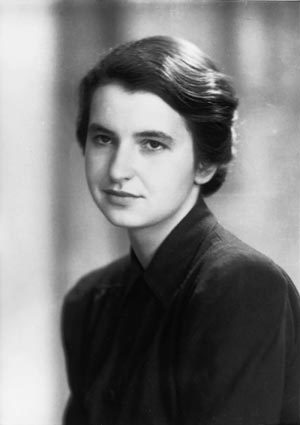Today I bring you a British biophysicist that is integral to the spirals of science history, and to the very understanding we have of what makes us, us… Rosalind Franklin.

Rosalind Franklin 1920-1958
In 1962 James D. Watson, Francis Crick and Maurice Wilkins won the Nobel Prize for Physiology or Medicine, for their work regarding the discoveries of the properties and appearance of DNA. However their work could not have been completed without the input of a fourth person – Rosalind Franklin. As Rosalind passed away in 1958 and the Nobel Prize can only be awarded to a maximum of three people (and not posthumously), Franklin was left out of the history books, and indeed when Crick and Watson’s study was published, Franklin’s only credit was how their work was ‘stimulated by experimental results from Kings College researchers’ as a footnote. It wasn’t until 1968 when Watson published his personal account of the discovery of DNA – The Double Helix – that Franklin’s work was truly acknowledged – although he did try to bury this under claims that she couldn’t read her own data, and constantly referred to her as Rosy – a patronising name she never used or liked.
So who was Rosalind Franklin, and what was her role in this scientific breakthrough? Franklin was born in London in 1920. At the age of 15 she decided she wanted to become a scientist, but her first battle was with her father, who didn’t believe in the education of girls. Once she won that one, she found herself at Cambridge… Women were not entitled to full degrees at the time and upon passing her finals in 1941, Franklin received a titular degree. She remained at Cambridge where she worked towards a PhD in physical chemistry, which she received in 1945.
In January 1951, Franklin became a research associate at Kings College London in the Medical Research Council’s biophysics unit. She was a highly skilled x-ray crystallographer and was originally employed to work on x-ray diffraction of proteins. However, before she even reached Kings College, unit director John Randall reassigned Franklin to work on x-ray diffraction of DNA. After WWII ended, the race for who could discover the structure of the DNA truly began. In 1953, Watson and Crick proposed the idea that the DNA’s structure was a double helix. This discovery was based on an x-ray diffraction image that Franklin took. This included the infamous photo 51 – an x-ray diffraction image of DNA, which was critical in identifying its structure. This photograph ultimately proved what Watson and Crick were thinking – DNA was a helical structure – and they set about building their now famous model.
Rosalind Franklin died on 16 April 1958, aged only 37, of bronchopneumonia, secondary carcinomatosis and carcinoma of the ovary – possibly caused by exposure to x-ray radiation. She remained unaware of the legacy she left behind her and the Nobel Prize that she should have shared in. She has since received some credit for her work, but if you’re ever in a pub quiz and are asked to name the discoverers of DNA, spare a thought for Rosalind Franklin.
No comments:
Post a Comment